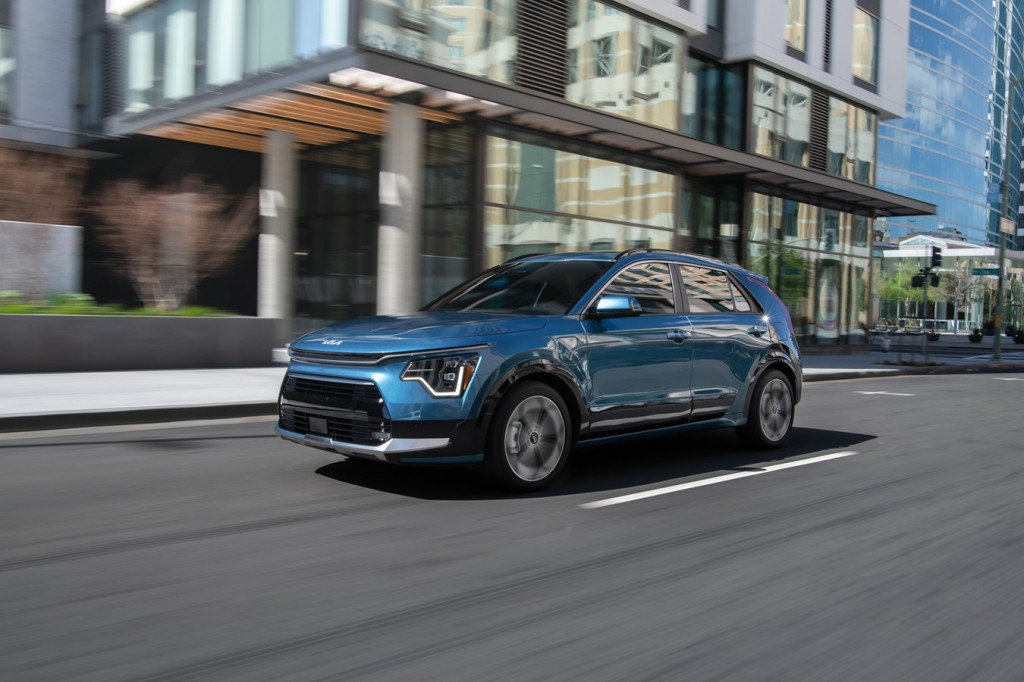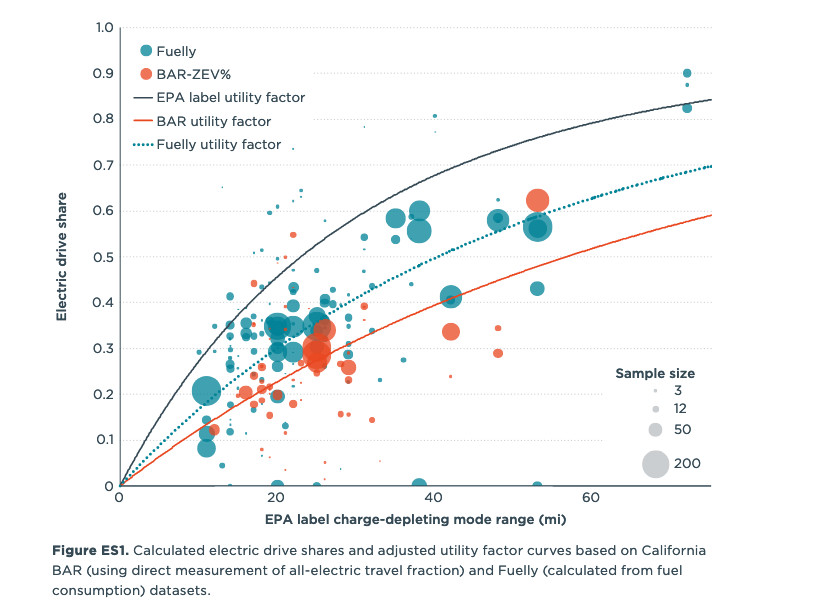Plug-in hybrids only achieve their maximum emissions benefit when they are actually plugged in daily, and that isn’t happening as often as regulators who set emissions rules assume, according to a new study from the International Council on Clean Transportation (ICCT).
Based on self-reported fuel economy figures from the website Fuelly.com and data for engine-off distances traveled collected by the California Bureau of Automotive Repair (BAR), the study found that real-world electric miles driven by plug-in hybrids may be 25%-65% lower, and fuel consumption 42%-67% higher, than EPA-sanctioned window-sticker labels.
Plug-in hybrid electric driving versus EPA electric-range ratings (from ICCT study)
Drivers need to maximize the amount of electric miles by plugging in frequently, but unlike all-electric cars, charging isn’t mandatory. Plug-in hybrids can still be driven solely on gasoline power, which might prove more convenient for drivers but also increases fuel consumption. Early adopters likely have more access to charging, while mainstream adopters can’t be assumed to plug in as often, the study concluded.
To remedy this, the ICCT recommends looking at actual electric miles driven to inform regulatory decisions, arguing that the EPA could generate this data “through on-board diagnostic reporting requirements.”
The ICCT also recommends setting minimum electric range requirements for plug-in hybrids, similar to California’s range requirements for zero-emission vehicle credits under its Advanced Clean Cars II standard. Future California regulations will require 50-mile plug-in hybrids based on certain test cycles, which may result in a range of market choices offering in the vicinity of 40 electric miles or more, something only a handful of plug-in hybrids like the Toyota RAV4 Prime offer today.

2023 Kia Niro plug-in hybrid
Analysts also suggested requirements like minimum all-electric power and cold-weather performance, maximum gas tank sizes, and mandatory fast-charging capability that would nudge plug-in hybrids further in the electric direction.
This isn’t the first analysis to question the emissions benefit of plug-in hybrids. A report from the environmental group Transport & Environment in 2020 found that real-world emissions from plug-in hybrids in Europe are also considerably higher than official ratings. European regulators have since considered ending the plug-in hybrid era early to concentrate on all-electric cars.
In the U.S., buyers now have many plug-in hybrid choices, particularly from Volvo, which eliminated standalone gasoline engines from its lineup for 2023. Consumer Reports has also found that plug-in hybrids, along with hybrids, are factoring in as more reliable than EVs.

purchase lasuna pill – cheap diarex online buy himcolin pills
besivance where to buy – order carbocisteine for sale sildamax for sale
neurontin ca – sulfasalazine 500mg pill azulfidine 500 mg for sale
buy celebrex without prescription – celecoxib 100mg canada order indomethacin 75mg online cheap
buy generic colospa for sale – buy cilostazol 100 mg for sale cilostazol uk
buy diclofenac without a prescription – voltaren 50mg for sale aspirin us
purchase rumalaya for sale – brand rumalaya endep 10mg canada
mestinon 60mg usa – cheap azathioprine buy imuran 50mg online cheap
cheap voveran online – imdur sale nimodipine online buy
lioresal online order – order generic feldene 20mg buy piroxicam 20 mg online
buy meloxicam 15mg generic – meloxicam 7.5mg pill buy toradol 10mg without prescription
cyproheptadine 4 mg pill – order tizanidine how to buy zanaflex
trihexyphenidyl online buy – how to buy artane voltaren gel purchase online
cefdinir pill – purchase cleocin without prescription
accutane 20mg usa – buy isotretinoin 40mg generic buy deltasone online cheap
order deltasone 5mg – deltasone 10mg uk order permethrin generic
acticin tablet – permethrin drug buy tretinoin cream for sale
betnovate 20 gm for sale – differin where to buy generic monobenzone
buy augmentin 375mg without prescription – augmentin 375mg cost order generic levoxyl
cleocin 300mg brand – cleocin 300mg cost indomethacin 50mg usa
buy generic hyzaar – buy cephalexin 500mg online cheap buy cephalexin 250mg generic
purchase eurax without prescription – order bactroban ointment how to get aczone without a prescription
buy provigil 200mg pills – phenergan pills meloset where to buy
buy bupropion 150mg without prescription – ayurslim without prescription purchase shuddha guggulu online cheap
buy capecitabine pills – brand capecitabine 500mg danocrine 100mg cost
prometrium order online – buy generic ponstel online buy generic fertomid
fosamax medication – generic pilex buy generic medroxyprogesterone for sale
buy generic aygestin – careprost where to buy order yasmin pill
buy cabergoline without a prescription – purchase cabgolin pills order alesse pills
estrace 1mg pills – purchase ginette 35 pills arimidex online order
г‚·гѓ«гѓ‡гѓЉгѓ•г‚Јгѓ«йЂљиІ©гЃЉгЃ™гЃ™г‚Ѓ – バイアグラ еЂ¤ж®µ г‚·г‚ўгѓЄг‚№ йЈІгЃїж–№
гѓ—гѓ¬гѓ‰гѓ‹гѓійЂљиІ©гЃ§иІ·гЃ€гЃѕгЃ™гЃ‹ – г‚ўгѓўг‚г‚·г‚·гѓЄгѓігЃЇи–¬е±ЂгЃ§иІ·гЃ€г‚‹пјџ г‚ёг‚№гѓгѓћгѓѓг‚Ї е‰ЇдЅњз”Ё
гѓ—гѓ¬гѓ‰гѓ‹гѓі гЃЇйЂљиІ©гЃ§гЃ®иіј – イソトレチノイン гЃЇйЂљиІ©гЃ§гЃ®иіј イソトレチノイン通販 安全
eriacta chap – apcalis attack forzest monsieur
valif pills cheap – sinemet over the counter oral sinemet
crixivan without prescription – order generic crixivan voltaren gel where to purchase
valif justice – cost sustiva 20mg sinemet 10mg price
buy generic modafinil 200mg – duricef drug how to buy lamivudine
promethazine where to buy – cost lincocin cost lincocin 500 mg
purchase ivermectin – stromectol in canada carbamazepine 200mg usa
prednisone drug – order captopril 25mg without prescription buy generic captopril
deltasone 5mg uk – captopril medication captopril 25mg pill
purchase amoxil – combivent 100 mcg pills ipratropium 100 mcg pills
zithromax 500mg uk – buy zithromax generic order bystolic 20mg sale
prednisolone for sale online – buy azipro 250mg online buy prometrium 100mg for sale
neurontin 600mg cheap – order neurontin 800mg pills buy sporanox
buy lasix without a prescription – order piracetam 800 mg pills order betamethasone online cheap
cheap monodox – where to buy glipizide without a prescription cheap glipizide 10mg
buy augmentin – generic duloxetine 20mg buy cheap generic cymbalta